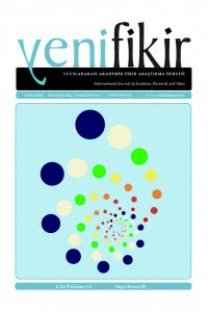Zihin Felsefesi Çalışmaları: Görünenden Gerçekliğe Geçişte Beş Farklı Yaklaşım
Çağdaş zihin felsefesi, bilinç, beden, fenomenal deneyim, qualia, fiziksel yön, fenomenal yön.
Philosophy of Mind Studies: Five Different Approaches in Transition from Apparent to Reality
Contemporary philosophy of mind, consciousness, body, phenomenal experience, qualia, physical aspect, phenomenal aspect.,
___
- Bailey A. (der.) (2019). Zihin Felsefesi, (Çev. Füsun Doruker. Ankara: Fol Kitap.
- Blackmore, S. (2021). Bilinç Üzerine Konuşmalar, (Çev. Seda Akbıyık) İstanbul: Küre Yayınları.
- Chalmers, D. (1995). “Facing up to the Problem of Consciousness”. Journal of Consciousness Studies, 2 (3): 200-219.
- Chalmers, D. (1998). “On the Search for the Neural Correlate of Consciousness”. In (eds. S. Hameroff, A. Kaszniak, A. Scott). Toward a Science of Consciousness II. MIT Press.
- Chalmers, D. (2011). “The Problem of Consciousness”. Discusiones Filosóficas, 12 (19): 29 – 59.
- Churchland, P. M. (2018). Madde ve Bilinç, (Çev. Berkay Ersöz) İstanbul: Alfa Yayıncılık.
- Churchland, P.S. (2019). Nörofelsefe, (Çev. Özge Yılmaz) İstanbul: Alfa Yayıncılık.
- Dennett, D. (2020). Bilinç Açıklanıyor (Çev. Sibel Kibar) İstanbul: Alfa Yayıncılık.
- Hail, J. (2020). Zihin Felsefesi: Çağdaş Bir Giriş, (Çev. Seda Akbıyık, Merve Bilgili) İstanbul: Küre Yayınları.
- Jackson, M. (1986). “What Mary Didn’t Know”. The Journal of Philosophy, Volume 83 (5): 291-295.
- Levine J. (1983). “Materıalism and Qualia: The Explanatory Gap”. Pacific Philosophical Quarterly, 64: 354-361.
- Manzotti, R. (2020). “Relative Existence and Experlence”. Phainomena, 1 (2): 11-33.
- Mcginn, C. (1989). “Can We Solve the Mind-Body Problem?” Oxford University Press, Mind, 98 (391): 349-366.
- Nagel, T. (1974). “What is it like to be a Bat?” The Philosophical Review, 83 (4): 435-450.
- Priest, S. (2018). Zihin Üzerine Teoriler, (Çev. Ayhan Dereko) İstanbul: Litera Yayıncılık.
- Revonsuo, A. (2017). Bilinç Öznelliğin Bilimi, (Çev. Selim Değirmenci) İstanbul: Küre Yayınları.
- Ryle, G. (2009). The Consept of Mind. London, United Kingdom: Routledge.
- Sayan, E. (2012). “Analitik Zihin Felsefesinin Temel Problemlerine Bir Bakış.” Kaygı, 19: 37-54.
- Searle, J. (2016). Bilinç ve Dil, (Çev. Muhittin Macit, Cüneyt Özpilavcı) İstanbul: Litera Yayıncılık.
- Searle, J. (2018). Bilincin Gizemi, (Çev. İlknur Karagöz İçyüz) İstanbul: Küre Yayınları.
- Tura, S. M. (2018). Zor Problem: Bilinç. İstanbul: Metis Yayıncılık.
- Zeman, A. (2017). Bilinç Kullanım Kılavuzu, (Çev. Gürol Koca) İstanbul: Metis Yayıncılık.
- ISSN: 1308-9412
- Başlangıç: 2009
- Yayıncı: Yeni Fikir Stratejik Araştırmalar Derneği
Seramik Malzemenin Kullanım Alanları ve Ülkemizde “Seramik Üniversitesi” Kurulması Önerisi
İşletmelerin KSS Uygulamalarının Yerli ve Yabancı Tüketicilerin Bakış Açısı ile Karşılaştırılması
Kevser ARMAN, Celalettin SERİNKAN
Yöneticilikte Adaletsizliği Meşrulaştırma Yöntemleri
Kolektif Hafıza ve Sanat Pratiğinin Mekânı Olarak Atölye
Zihin Felsefesi Çalışmaları: Görünenden Gerçekliğe Geçişte Beş Farklı Yaklaşım
Pandemi Döneminde Hizmet Alan Bireylerin Ortaya Çıkan İç Yüzleri: Duyarlılar ve Duyarsızlar
Türkiye Cumhuriyeti’nin İlk İktisat Bakanı Hasan Saka ve Tbmm’deki Faaliyetleri (1923-1926)
